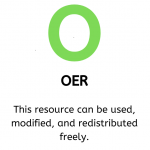Developed by Elizabeth Stone, Political Science, Baruch College, CUNY
Professor Stone teaches Introduction to American Government (POL1101). An Open Education Resource she uses is the Federalist Papers No. 10, 39, and 51. These essays are in the public domain and available online through Project Gutenberg.
Professor Stone’s course easily incorporated OER because the course is designed to use as many primary source materials as possible and does not include a textbook. This allows students to directly engage with historical readings, rather than learning about them second-hand or only reading short excerpts in a textbook. Professor Stone chose these three Papers (10, 39, 51) because they are foundational examples of the Federalist Papers as a whole, and the key questions they raised about governmental power, the nature of tyranny, and representation — perennial questions in American politics that we return to throughout the course.
The oer & Course Artifact
OER Files:
- Madison’s Federalist Papers: 10, 39, 51
- Ratification Debates_OER (Powerpoint)
- The Complete Federalist Papers on Project Gutenberg
Students read these three Federalist Papers alongside two Anti-Federalist writings, the Brutus essays No. 2 and 5. Students consider the following questions together in class on the key disagreements between the Federalists and the Anti-Federalists. Note: the excerpts below are pulled directly from my PowerPoint presentation for this class.
Key disagreements between the Feds and Anti-Feds:
- Representation
- Anti-Feds: representatives must be true reflection of the people
- Feds: government must be representative of the people but have some autonomy from the people
- Tyranny
- Anti-Feds: governments tend to become “aristocratic,” where small group uses power to tyrannize the many
- Feds: more concerned about tyranny of the majority – populist uprisings
- Governmental power
- Both wanted limited governmental power but disagreed on how to limit
- Anti-Feds: national government’s powers limited and spelled out (enumerated)
- Supported Bill of Rights to protect states and people
- Feds: stronger national government was worth the risk
- Opposed Bill of Rights for potentially weakening national government
Then in small groups, students answer the following questions — each group answers the questions for one reading, then share their answers with the class. Their answers are then posted on Blackboard, so students can refer to them when studying for the midterm exam.
- Federalist No. 10:
- What is a “faction”? What are the sources of factions?
- If factions cannot be prevented, how does the Constitution mitigate their effects? (2 ways)
- Federalist No. 39:
- Is the proposed government a republic? What makes a republic?
- Is the proposed government a federal or national government?
- Federalist No. 51:
- How will the Constitution ensure that governmental powers (legislative, executive, judicial) will remain separated?
- How does the Constitution ensure the protection of liberty?
- What is the “great security” against concentration of power?
This exercise requires students to think both specifically about the reading — defining key terms, identifying theses — and to think about the historical and political role these writings played in American political development, i.e., attempting to sway public opinion on the larger questions of representation, tyranny, and governmental power. It also provides an opportunity to relate these debates to contemporary issues in American politics with which students are more likely to be familiar, to identify continuity and change in political debate over time.
transitioning to and Teaching with oer
To create the documents above, Professor Stone copied the text directly from the Project Gutenberg website and created a PDF out of the selected readings. This document is made available to students on the course website in PDF form and Professor Stone includes a link to the Project Gutenberg website if they want to see the three readings in context (among the rest of the 85 Papers). The value for students is that they have a single PDF with a few of the most iconic Federalist Papers that they can return to as they take more advanced political science courses.
Through participating in Baruch College’s OER seminar and converting her course to OER/ZTC, Professor Stone reported becoming more thoughtful about where the resources on her syllabus originate, how easily accessible the resources are for her students, and the importance of students being able to retain and reuse those resources after the class ends.
Professor Stone recommends OER online textbooks for anyone teaching a course without a textbook since, every semester a few of her students ask for a recommended textbook they can read alongside the assigned readings for additional context. This is particularly useful for exchange students or students who are unfamiliar with the basic functions of the U.S. government. Professor Stone would recommend the OER Commons American Government textbook.
Faculty Information
Elizabeth Stone is a graduate teaching fellow at the Graduate Center and Baruch College, CUNY. Her research uses ordinary language analysis to investigate how language shapes U.S. policy development.
Licensing information
![]() The Federalists and Anti-Federalists assignment is licensed under a Creative Commons Attribution-NonCommercial-ShareAlike 4.0 International License.
The Federalists and Anti-Federalists assignment is licensed under a Creative Commons Attribution-NonCommercial-ShareAlike 4.0 International License.
 The materials linked above, including the Federalist Papers and the PowerPoint slideshow, are OER.
The materials linked above, including the Federalist Papers and the PowerPoint slideshow, are OER.

